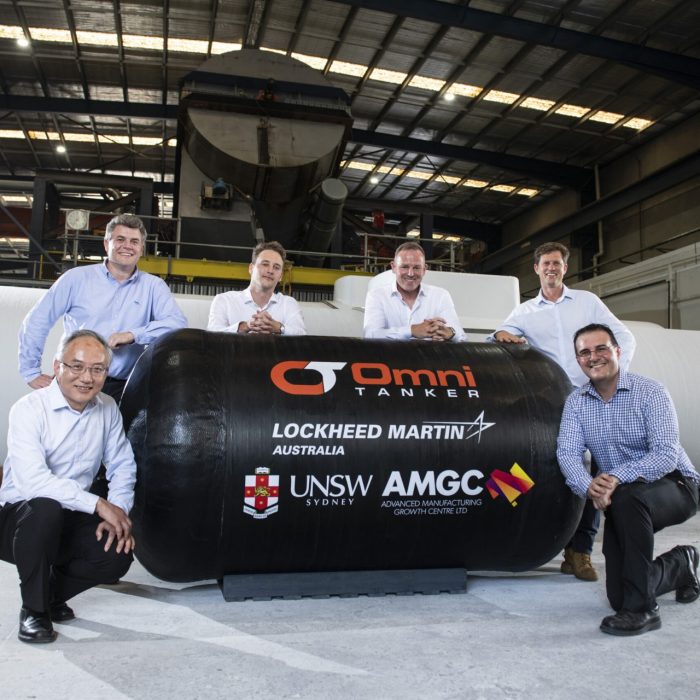Advanced Carbon Fibre Composites

Carbon fibre composite tanks are emerging as a tremendous opportunity for energy-efficient storage of liquid hydrogen (LH2) as they offer potential weight savings relative to existing metal tanks or composite-wrapped metal tanks. However, the formation of through-thickness cracks in carbon fibre composites at the ultracold LH2 temperature remains the most significant challenge to the use of all-composite hydrogen tanks, as the microcracks cause leakages of hydrogen and reduce structural integrity.
Funded by the ARC Discovery Projects (DP190102790 & DP230101204), the UNSW research team led by Scientia Professor Chun Wang, including A/Prof Garth Pearce and Dr Wenkai Chang, aims to develop innovative technologies to enhance the performance of carbon fibre composites to withstand thermal-mechanical loading at the cryogenic LH2 temperature without suffering from transverse matrix cracking and ply splitting.
Innovative technologies include:
- nanomaterials and hybrid toughening technologies to toughen advanced carbon fibre composites, e.g., through the incorporation of multiple nanomaterials in the epoxy matrix to increase their fracture toughness at cryogenic temperatures, and
- ply-thickness engineering to suppress the growth of microcracks by hybridising standard-ply and thin-ply composites to achieve optimum anti-leakage properties at LH2 temperature.
This project also develops a physics-based multi-scale computational model spanning nanoscale to macroscale to understand the mechanisms and to quantify the effectiveness of the various toughening strategies, with a view of developing an Integrated Computational Materials Engineering (ICME) framework for advanced carbon fibre composites at cryogenic LH2 temperature.
Recently, the research team has achieved significant advancements in toughening carbon fibre-reinforced composites at cryogenic temperatures. The innovation paves the way for the development of lightweight all-composite vessels capable of safely transporting and storing liquid hydrogen at -253 °C and has now been patented and adopted by Lockheed Martin and Omni Tanker for large-scale commercial applications for storage and transport of liquid hydrogen Media Release.
This marks a major milestone in enabling composite vessels to operate at liquid hydrogen temperatures without matrix cracks, a challenge that has, up until now, prevented mass-market adoption of these materials for such applications.
-
The University of New South Wales (UNSW)
-
- Australian Research Council’s Discovery Grant Program (DP230101204)
- Australian Research Council’s Discovery Grant Program (DP190102790)
-
The Advanced Manufacturing Growth Centre (AMGC), Omni Tanker Pty Ltd
-
- 10th Australasian Congress on Applied Mechanics, 29 November – 1 December 2021
- 12th International Conference on Structural Integrity and Failure, 5 – 8 December 2021
- 13th International Conference on Structural Integrity and Failure, 6 – 9 December 2022
- 17th Pacific Polymer Conference, 11 – 14 December 2022
- 12th Asian-Australasian Conference on Composite Materials, 25 – 28 April 2023
- 11th Australasian Congress on Applied Mechanics, 7 – 9 February 2024
-
W. Chang, L.R.F. Rose, M.S. Islam, S. Wu, S. Peng, F. Huang, A.J. Kinloch, C.H. Wang, Strengthening and toughening epoxy polymer at cryogenic temperature using cupric oxide nanorods, Composites Science and Technology, 208 (2021), p. 108762.
W. Chang, L.R.F. Rose, S. Wu, A.J. Kinloch, C.H. Wang, Increasing crack growth resistance for through-thickness matrix cracking and its role in suppressing ply cracking in thin-ply laminates, Composites Part A: Applied Science and Manufacturing, 163 (2022), p. 107219.
W. Chang, L.R.F. Rose, Z. Sha, F. Huang, A.J. Kinloch, C.H. Wang, Multiscale modelling of nanoparticle toughening in epoxy: effects of particle-matrix interface, particle size and volume fraction, Composites Science and Technology (Under Review).
L.F. Benninger, M.S. Islam, C.H. Wang, J.P. Calibeo, Storage vessels with fiber composite reinforcement, US Patent 11841112 (2023).
J. Wang, W. Chang, M.S. Islam, F. Huang, S. Wu, L.R.F. Rose, J. Zhang, C.H. Wang, Toughening epoxy by nano-structured block copolymer to mitigate matrix microcracking of carbon fibre composites at cryogenic temperatures, Composites Science and Technology (2024), p. 110548.
M.S. Islam, L.F. Benninger, G. Pearce, C.H. Wang, Toughening carbon fibre composites at cryogenic temperatures using low-thermal expansion nanoparticles, Composites Part A: Applied Science and Manufacturing, 150 (2021) 106613.
M.S. Islam, W. Chang, Z. Sha, J. Wang, S. Wu, L.R.F. Rose, A.J. Kinloch, C.H. Wang, Mitigating cryogenic microcracking in carbon-fibre reinforced polymer composites using negative thermal-expansion nanoparticles functionalised by a polydopamine coating, Composites Part B: Engineering, 257 (2023)
W. Chang, L.R.F. Rose, S. Wu, A.J. Kinloch, C.H. Wang, Through-thickness crack growth resistance in fibre composites and its role in preventing ply cracking in cross-ply laminates, Engineering Archive, (2022).
